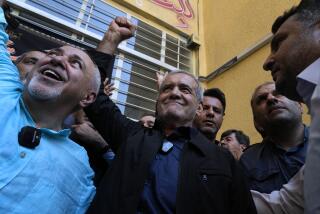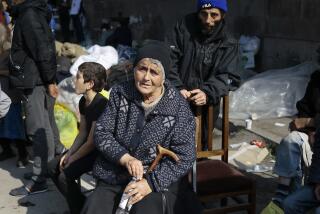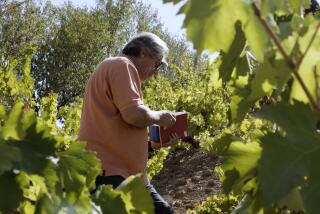Iran Makes Trade Inroads in Soviet Asian Republics : Economics: New border crossings and trade exhibitions promote ties between Islamic neighbors.
- Share via
ASHKHABAD, Soviet Union — The grimy, state-owned Ashkhabad Hotel was teeming with hundreds of Iranians, representing dozens of businesses in the northern provinces that lie just beyond the nearby mountains that the people of Turkmenistan call Nebet-Dag.
They came here to sell anti-freeze, pistachio nuts, leather jackets, batteries, detergent, blue jeans, kiwi fruit, key-cutting machines, porcelain sinks, toilets--and just a bit of what was labeled “Islamic Propaganda” on one wall of their huge trade exhibit at the nearby Turkmenistan Exhibition Hall.
The display included a painting of a human skull superimposed over the American flag.
The scene in Ashkhabad, the capital of the Soviet Central Asian republic of Turkmenistan, provided a glimpse of Iran’s overall strategy of economic--and perhaps religious--conquest as the region’s republics prepare to break off from Moscow and go their own way.
There are plenty of other signs right here in Turkmenistan.
Thirty miles south of Ashkhabad, Turkmenistan President Saparmurad A. Niyazov was standing beside a senior Iranian official who had the long white beard of an Islamic clergyman. The occasion was an official opening ceremony at one of three new border crossings between Iran and Niyazov’s emerging nation.
And in Niyazov’s Communist Party media, senior Turkmenistan economic officials were praising Iran as their best potential trading partner, now that the republic has decided to officially declare its independence on Oct. 27.
The officials had just announced that Turkmenistan’s first major contract under new Soviet regulations permitting it to go into business for itself was with a large Iranian concern across the border.
But it was the Iranian trade fair in Ashkhabad that provided the most graphic proof of Turkmenistan’s new economic orientation.
The Iranians had come not only to sell but also to buy: natural gas, polyethylene pipes, asbestos, mineral ore, cotton and other raw materials that Turkmenistan had long been forced to send to the Soviet republics to the north for little or no profit.
“It’s really a revival of the old Silk Road, which begins in China, travels through these new countries and then on to Turkey and Europe,” said Shahrokh Modarres, the Iranian official who organized the trade exhibition for his fundamentalist Islamic government.
This was his third trade fair in far-flung Soviet republics. Similar exhibitions were held this summer in the Tadzhikistan capital of Dushanbe and Kazakhstan’s capital of Alma-Ata.
The results of those two trade fairs, according to Modarres: more than $1.5 billion in new contracts between Iran and the republics.
Modarres readily conceded that as much as 75% of the new deals will be in barter trade, since the Soviet republics are even shorter on hard currency than his own nation. But, he stressed, his traveling trade show is clearly seen in Tehran as a critical investment in the future.
The Iranian official spoke of redrawing the entire economic map of Asia since the Soviet empire appears all but dead.
“There is a tremendous amount of change taking place in this region right now, and Iran is naturally trying to capitalize on it,” he said. “This exhibition is merely an investment. I am much more interested, 10 years down the road, in the confederations that will form naturally.”
When asked about the political and religious impact of Iran’s economic expansion into a region where the majority of residents are long-repressed Muslims, Modarres said: “These are questions of policy, and the answers are only with Tehran. I don’t know about the politics.”
Many others in the region, however, are thinking about the political implications. Some analysts believe there is fertile ground for a renaissance of Islamic fundamentalism in all the Central Asian republics with the possible exception of Kirghizia, whose external border is with China.
Turkmenistan, by contrast, shares an 800-mile border with Iran, and Modarres said it falls naturally into Iran’s sphere of geographic influence.
In Tadzhikistan, the people speak Iran’s language and share cultural roots.
In fact, the most strident opposition to the hard-line Communist takeover of Tadzhikistan’s government on Sept. 23 came from members of the republic’s burgeoning Islamic political parties. They have erected a tent city of protest in newly renamed Liberty Square outside the Parliament building in Dushanbe.
Tadzhikistan “is really the future for Iran,” Modarres said. “It is a country with the same religion of Iran. They have the same language, the same culture. They like the Iranians very much there. We felt very much at home.”
And in the mineral-rich republic of Uzbekistan, Modarres said, he is hoping to stage “the biggest trade exhibition yet” next year in the capital of Tashkent. Iran is interested not only in establishing similar cultural links but also in tapping into the new nation’s strategic reserves of gold and natural gas.
“Tashkent is really the center of the Islamic republics and now, if you look at it from a strategic point of view, to business in that area, you start building your base,” said Charles Rudd, a longtime California resident whose company, Interconcepts Inc., opened a branch office in Tashkent a year ago.
“It should be of some concern to American business, though, the way the Iranians are already establishing themselves in the region,” Rudd said. “The Iranians and the republics already have agreed to build a railroad across the Turkmenistan border, so they seem to be way ahead.”
Modarres said the railroad will again link Iran to western China, whose markets represent the most lucrative potential in Iran’s search for export earnings.
“Having conquered the market and established strong relations with Turkmenistan, it will open up all the doors for us to conquer China,” he said. “So you see, as these very big changes are happening around us, we are already here.”
More to Read
Sign up for Essential California
The most important California stories and recommendations in your inbox every morning.
You may occasionally receive promotional content from the Los Angeles Times.










